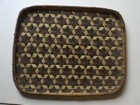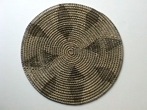Weaving


Weaving



INTRODUCTION
Weaving has its roots in basket making, and is a skill that was mastered a very long time ago. Man had learned to weave as early as the New Stone Age. From the fibers of the flax plant, he had learned to weave linen cloth. Archaeologists discovered an image of a loom on a pottery dish that dates from 4400 B.C. It was found in an Egyptian tomb. As long ago as 1766 B.C. the Chinese developed a complicated loom for weaving silk. About the same time, the people of India discovered how to make cloth from the fibers of the cotton plant. As soon as people discovered how to create fabric, they figured out ways to cross the different threads to make beautiful patterns.
Colorful tapestries were woven in Persia, and later in Europe.
Weaving consists of arranging a group of lengthwise threads in rows, very close together. Crosswise threads are then laced over and under the vertical threads. Ancient weavers strung the lengthwise threads on a frame, and passed the crosswise threads over and under them with a shuttle (similar to a large needle). Until the late 1700's, most people produced their own cloth at home.

Weaving is an experience that we can begin to share with children from about four years of age. Parallel to weaving activities, the teacher can talk to the children about where we get our clothes from and show them pictures of looms and how things are woven. Show the children different materials like wool, silk, cotton, as well as different weaving patterns. It is fun to analyze with the children the bold and intricate weaving patterns used in baskets from different cultures.


Bring in primitive weaving with bright colors, and examples from many parts of the world. Throughout our handwork curriculum, one of our main goals is to enlarge children's knowledge and appreciation of how people have met their basic needs over time and in different cultures.
Whenever we begin teaching a new skill, we start very simply. When the fundamental skills are mastered, we lead the children on to greater understanding and refinement.
For all the following activities, the orientation is toward involving the child with materials and process, not toward the finished product. The important focus is to help children experience the joy of these arts. Our sample activities will be woven with paper, but many other materials may be used:
Raffia Wicker Crepe Paper Pipe Cleaners Yarn
Thin Twigs Ribbons Feathers Field Grasses Dried Flowers
Corn Husks Metallic Wire Fabric Burlap Fish Net
Twine Rug Canvas Mesh Dishcloths Vegetable Sacks Fruit Sacks









